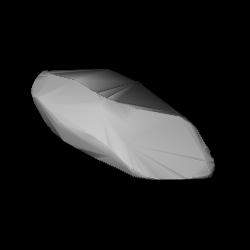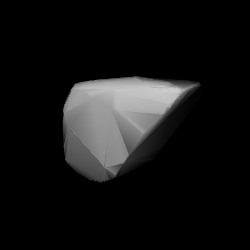Related Research Articles
2072 Kosmodemyanskaya, provisional designation 1973 QE2, is a stony asteroid from the inner regions of the asteroid belt, approximately 6 kilometers in diameter.
11264 Claudiomaccone (provisional designation 1979 UC4) is a stony background asteroid and binary system from the middle regions of the asteroid belt, approximately 3 kilometers in diameter. It was discovered 16 October 1979, by Nikolai Chernykh at Crimean Astrophysical Observatory in Nauchnyj, on the Crimean peninsula. It was named after the Italian astronomer Claudio Maccone.
2006 Polonskaya (provisional designation: 1973 SB3) is a stony Flora asteroid and asynchronous binary system from the inner regions of the asteroid belt, approximately 5 kilometers (3.1 miles) in diameter. It was discovered on 22 September 1973, by Soviet astronomer Nikolai Chernykh at the Crimean Astrophysical Observatory in Nauchnij, on the Crimean peninsula, and later named after Ukrainian astronomer Elena Kazimirtchak-Polonskaïa. Its one-kilometer-sized satellite was discovered by an international collaboration of astronomers in November 2005.
1052 Belgica, provisional designation 1925 VD, is a binary Florian asteroid from the inner regions of the asteroid belt, approximately 10 kilometers in diameter. It was discovered on 15 November 1925, by Belgian astronomer Eugène Delporte at Uccle Observatory in Belgium. It was the first minor planet discovered at Uccle Observatory, after which the minor planet 1276 Ucclia was named.
1123 Shapleya, provisional designation 1928 ST, is a stony Florian asteroid from the inner regions of the asteroid belt, approximately 11 kilometers in diameter. It was discovered on 21 September 1928, by Russian astronomer Grigory Neujmin at Simeiz Observatory on the Crimean peninsula. It was named after American astronomer Harlow Shapley.
3067 Akhmatova, provisional designation 1982 TE2, is a stony Flora asteroid from the inner regions of the asteroid belt, approximately 6 kilometers in diameter.
2033 Basilea, provisional designation 1973 CA, is a stony asteroid from the inner regions of the asteroid belt, approximately 6 kilometers in diameter. It was discovered on 6 February 1973, by astronomer Paul Wild at the Zimmerwald Observatory near Bern, Switzerland. The asteroid was named for the Swiss city of Basel.
4029 Bridges, provisional designation 1982 KC1, is a stony asteroid and binary system from the middle regions of the asteroid belt, approximately 8 kilometers in diameter.

1338 Duponta, provisional designation 1934 XA, is a stony Florian asteroid and synchronous binary system from the inner regions of the asteroid belt, approximately 7.8 kilometers in diameter.
5905 Johnson, provisional designation 1989 CJ1, is a Hungaria asteroid and synchronous binary system from the innermost regions of the asteroid belt, approximately 4 kilometers (2.5 miles) in diameter. It was discovered on 11 February 1989, by American astronomer Eleanor Helin at Palomar Observatory in California, United States. Its satellite measures approximately 1.6 km (1 mi) in diameter and orbits its primary every 21.8 hours. It was named after American astronomer and engineer Lindley N. Johnson.
2140 Kemerovo, provisional designation 1970 PE, is a dark asteroid from the outer region of the asteroid belt, approximately 30 kilometers in diameter.

2094 Magnitka (prov. designation: 1971 TC2) is a Flora asteroid from the inner regions of the asteroid belt, approximately 12 kilometers (7.5 miles) in diameter. It was discovered on 12 October 1971, at and by the Crimean Astrophysical Observatory in Nauchnyj, on the Crimean peninsula. The discovery has not been attributed to an observing astronomer. It was later named for the city of Magnitogorsk.
1771 Makover, provisional designation 1968 BD, is a carbonaceous asteroid from the outer region of the asteroid belt, approximately 50 kilometers in diameter.
1739 Meyermann, provisional designation 1939 PF, is a stony Florian asteroid from the inner regions of the asteroid belt, approximately 7.5 kilometers in diameter. It was discovered by German astronomer Karl Reinmuth at Heidelberg Observatory on 15 August 1939. It was later named in memory of astronomer Bruno Meyermann.
2122 Pyatiletka, provisional designation 1971 XB, is a stony asteroid from the inner regions of the asteroid belt, approximately 11 kilometers in diameter.
1907 Rudneva, provisional designation 1972 RC2, is a stony background asteroid from the central regions of the asteroid belt, approximately 11 kilometers in diameter. It was discovered on 11 September 1972, by astronomer Nikolai Chernykh at the Crimean Astrophysical Observatory, Nauchnyj, on the Crimean peninsula. The asteroid was named after Soviet geodesist and war hero Yevgeniya Rudneva.

1854 Skvortsov (prov. designation: 1968 UE1) is a stony background asteroid and relatively slow rotator from the middle region of the asteroid belt, approximately 9 kilometers in diameter. It was discovered on 22 October 1968, by Russian astronomer Tamara Smirnova at the Crimean Astrophysical Observatory in Nauchnyj on the Crimean peninsula. It is named after astronomer Evgenii Skvortsov.
1530 Rantaseppä, provisional designation 1938 SG, is a stony Florian asteroid from the inner regions of the asteroid belt, approximately 5 kilometers in diameter. Discovered by Yrjö Väisälä at Turku Observatory in 1938, it was later named after Finnish astronomer Hilkka Rantaseppä-Helenius.
1790 Volkov, provisional designation 1967 ER, is a stony Florian asteroid from the inner regions of the asteroid belt, approximately 8 kilometers in diameter.
3982 Kastelʹ, provisional designation 1984 JP1, is a Florian asteroid and a suspected binary system from the inner regions of the asteroid belt, approximately 6.9 kilometers in diameter.
References
- 1 2 3 4 5 6 "JPL Small-Body Database Browser: 1857 Parchomenko (1971 QS1)" (2017-05-05 last obs.). Jet Propulsion Laboratory. Archived from the original on 20 December 2016. Retrieved 8 June 2017.
- 1 2 3 Schmadel, Lutz D. (2007). "(1857) Parchomenko". Dictionary of Minor Planet Names – (1857) Parchomenko. Springer Berlin Heidelberg. p. 149. doi:10.1007/978-3-540-29925-7_1858. ISBN 978-3-540-00238-3.
- 1 2 3 4 5 6 "LCDB Data for (1857) Parchomenko". Asteroid Lightcurve Database (LCDB). Retrieved 13 December 2016.
- 1 2 3 Masiero, Joseph R.; Grav, T.; Mainzer, A. K.; Nugent, C. R.; Bauer, J. M.; Stevenson, R.; et al. (August 2014). "Main-belt Asteroids with WISE/NEOWISE: Near-infrared Albedos". The Astrophysical Journal. 791 (2): 11. arXiv: 1406.6645 . Bibcode:2014ApJ...791..121M. doi:10.1088/0004-637X/791/2/121 . Retrieved 13 December 2016.
- 1 2 3 4 Mainzer, A.; Grav, T.; Masiero, J.; Hand, E.; Bauer, J.; Tholen, D.; et al. (November 2011). "NEOWISE Studies of Spectrophotometrically Classified Asteroids: Preliminary Results". The Astrophysical Journal. 741 (2): 25. arXiv: 1109.6407 . Bibcode:2011ApJ...741...90M. doi:10.1088/0004-637X/741/2/90.
- 1 2 Behrend, Raoul. "Asteroids and comets rotation curves – (1857) Parchomenko". Geneva Observatory . Retrieved 13 December 2016.
- 1 2 3 Stephens, Robert D.; Warner, Brian D.; Pravec, Petr (September 2006). "1857 Parchomenko: a possible main-belt binary asteroids". The Minor Planet Bulletin. 33 (3): 52. Bibcode:2006MPBu...33...52S. ISSN 1052-8091 . Retrieved 13 December 2016.
- 1 2 "1857 Parchomenko (1971 QS1)". Minor Planet Center. Retrieved 13 December 2016.
- ↑ Schmadel, Lutz D. (2009). "Appendix – Publication Dates of the MPCs". Dictionary of Minor Planet Names – Addendum to Fifth Edition (2006–2008) . Springer Berlin Heidelberg. p. 221. doi:10.1007/978-3-642-01965-4. ISBN 978-3-642-01964-7.